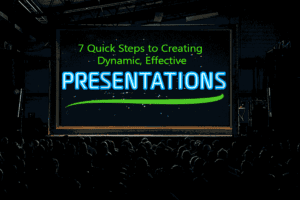7 Quick Steps to Creating Dynamic, Effective Presentations
Introduction
A presentation is a powerful communication tool that can be used to present ideas, persuade an audience, or simply inform. When done well, presentations can be both beautiful and effective.
However, designing a presentation that is both stunning and effective can be a challenge.
In this quick reference guide, we will explore the different aspects of presentation design, from choosing the right slides to making your presentation more engaging. We will also provide some helpful tips and resources that you can use to improve your presentation design skills. So, whether you are a seasoned professional or just starting out, this guide is for you!
1. Know Your Audience
The first step in designing an effective presentation is knowing your audience. Who are they? What are their interests and needs? What do they already know about the topic? This information will help you tailor your presentation to your audience and keep them engaged.
2. Choose the Right Slides
The slides you choose can make or break your presentation. Make sure to choose slides that support the main points of your presentation and are easy to read and understand. Avoid cluttered slides with too much information and opt for visuals that illustrate your points.
3. Use Color Wisely
Color can enhance the visual appeal of your presentation but use it wisely. Stick to a color scheme that is easy on the eyes and doesn’t distract from the content of your presentation. You can also use color to highlight important points or to create contrast between different elements.
4. Keep it Simple
Less is more!…when it comes to presentation design. Avoid overwhelming your audience with too many slides or too much information. Stick to the main points and use visuals and examples to illustrate your points. No one wants to be read to off a screen. Your passion for your topic should be spoken with eye contact, and the slides should serve more as a visual backdrop for your ideas, not a veritable book to be read. You don’t go to a movie to read the script on screen! You want relatable humans delivering to you a story…
5. Tell a Story
A presentation is more than just a collection of slides. It’s a story that you are telling to your audience. Make sure to structure your presentation like a story, with a clear beginning, middle, and end. This will keep your audience engaged and make your presentation more memorable.
6. Use Engaging and High-Quality Visuals
Visuals can add depth and interest to your presentation. Use photos, illustrations, charts, graphs, and video clips to illustrate your points and make your presentation more engaging. Just make sure to choose visuals that are relevant to your topic and easy to understand. If you are not backed by a company paying a subscription for an image bank, choosing to buy the rights to copyright-protected imagery from such sites can get expensive. If you go the free Google Images route, even if you filter for “large” images for best quality, you nonetheless run the risk of downloading images that are not royalty-free. Also, the “large” filter is not always a guarantee of high quality. Instead, try a free, royalty-free image bank link like Unsplash.com. And get bold! Create some full-page images in your presentation! If there are dark areas of your image that can be a great place for white type. Or light areas with black or dark gray type. If you don’t have facility with Photoshop to optimize images even further, you can find inexpensive help on Fiverr.com to help you. Look at high-end presentations that you feel might be beyond your ability to deliver and ask for help on Fiverr to edit your images but do not know how to repurpose effectively.
7. Practice, Practice, Practice!
No matter how beautiful your presentation is, it won’t be effective if you don’t practice. Make sure to practice your presentation several times before delivering it to your audience. This will help you feel more confident and deliver a polished presentation. If you are not all that great at public speaking, use the Notes function of your presentation software (available in both PowerPoint and Apple Keynote). If you can see them electronically at a lectern, or if you must print them for reference, it’s a much better option than reading huge columns of text off a screen which will be visually uninteresting and dull to your audience. Try not to read, but instead maximize eye contact as much as possible, so that you can be relatable and persuasive. Practice with a colleague so your delivery is as authentic and natural as you can make it.

